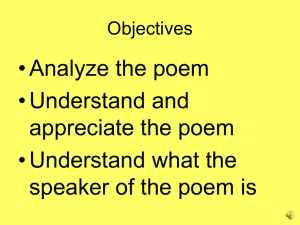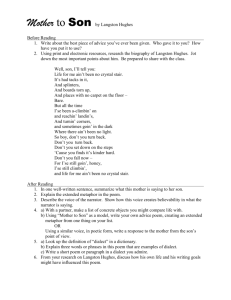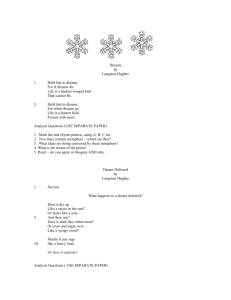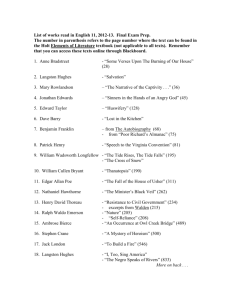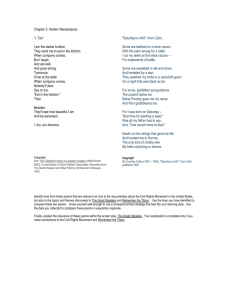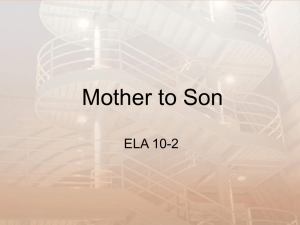Imagery
advertisement
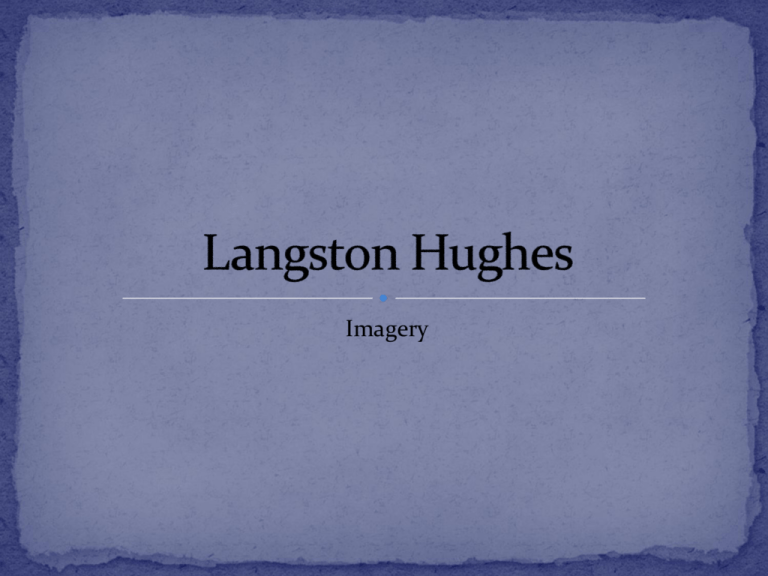
Imagery Bellwork 1/30 — Free‐write: Write about your dreams for the future. What do you dream about? Daily Objective — SPI 0701.8.10 Identify and analyze figurative language (i.e., hyperbole, simile, metaphor, personification, pun) within context. Langston Hughes Background Information — http://www.biography.com/people/langston‐ hughes‐9346313/videos/langston‐hughes‐mini‐ bio‐2174109638 — Write three facts about Langston Hughes from the video. — Imagery is language that appeals to the senses. Hold fast to dreams For if dreams die Life is a broken‐winged bird That cannot fly. Hold fast to dreams For when dreams go Life is a barren field Frozen with snow. 1. 2. 3. What do you see? What kinds of images did he create? What imagery devices (figurative language) did he use to create these images? From these images, what kind of mood did he create? http://www.youtube.com/watch?v=EpjFS3CQkKE the broken‐winged bird and the barren field How are these 2 images linked metaphorically to LIFE To fling my arms wide In some place of the sun, To whirl and to dance Till the white day is done. Then rest at cool evening Beneath a tall tree While night comes on gently, Dark like me‐ That is my dream! To fling my arms wide In the face of the sun, Dance! Whirl! Whirl! Till the quick day is done. Rest at pale evening... A tall, slim tree... Night coming tenderly Black like me. 1. What do you see? What kinds of images did he create? 2. What imagery devices (figurative language) did he use to create these images? 3. From these images, what kind of mood did he create? What happens to a dream deferred? Does it dry up Like a raisin in the sun? Or fester like a sore‐‐ And then run? Does it stink like rotten meat? Or crust and sugar over‐‐ like a syrupy sweet? Maybe it just sags like a heavy load. Or does it explode? 1. 2. 3. What do you see? What kinds of images did he create? What imagery devices (figurative language) did he use to create these images? From these images, what kind of mood did he create? What did we learn today? — SPI 0701.8.10 Identify and analyze figurative language (i.e., hyperbole, simile, metaphor, personification, pun) within context. Quickwrite – “Harlem Night Song” and “Winter Moon” — Step 1: Write about it: How does the night make you feel? Do you find it mysterious? Is it a time for dreaming? Or does the night make you fearful? Do you worry that dangerous creatures might be lurking in the dark? — Step 2: Take a moment and jot down the first five words that come into your mind when you think of the night. Page 565 ‐ Photograph — Imagine you are on the rooftop pictured in the photograph. Write what you would see, hear, smell, taste, and touch. Questions about “Harlem Night Song” and “Winter Moon” 1. Which image from these two poems stands out most clearly in your mind? 2. Who is the poet speaking to in “Harlem Night Song?” 3. Which images in “Harlem Night Song” appeal to sight? 4. Which images in “Harlem Night Song” appeal to hearing? 5. Which qualities of the moon have the strongest impact on the speaker in “Winter Moon?” 6. Draw a picture of the moon as it is described in “Winter Moon.” Writing your own Imagery Poem — Think of favorite place. Use your senses — Fill in the following: — I see_____________________ — I hear____________________ — I smell___________________ — I taste___________________ — I feel_____________________ — I think___________________ Table of Contents — Color Poem……..1 — Personification Poem……2 — Imagery Poem…..3 — Final Draft: — Take out the beginning (I see, I smell, etc.) of each line. — Remove any articles (a, an, etc.) — Rewrite the final poem using only the phrases. Example: Sun glistening on blue water, Salty breeze blowing, Waves crashing on the shore, Hot sand sticking to my toes, Frozen strawberry slush on my tongue, Might stay here forever. — The Harlem Renaissance, originally called the New Negro Movement, was a time in the 1920’s and 1930’s when new black writing and music (jazz) was becoming very popular despite little economic opportunities and racism. — Writing and music became a popular way for people to creatively express themselves — The timing of this coming‐of‐age was perfect. The years between World War I and the Great Depression were boom times for the United States, and jobs were plentiful in cities, especially in the North. — Between 1920 and 1930, almost 750,000 African Americans left the South, and many of them migrated to urban areas in the North to take advantage of the prosperity—and the more racially tolerant environment. The Harlem section of Manhattan, which covers just 3 sq mi, drew nearly 175,000 African Americans, turning the neighborhood into the largest concentration of black people in the world. Write your own dream poem: — Write a poem about your dreams for life. — Include: — At least two stanzas — Title — Signature — 2 uses of figurative language (idiom, metaphor, simile, personification, allusion) – underline these two examples. — Due Thursday – February 17, 2011 — Each element is worth five points – total of 30 points — Read about Langston Hughes.http://www.kshs.or g/real_people/pdfs/hughes_ langston.pdf Explain what kind of person he was and what kind of poet he was. — Read his first published poem, “The Negro Speaks of Rivers” and try to explain why this became “his signature piece”. I've known rivers: I've known rivers ancient as the world and older than the flow of human blood in human veins. My soul has grown deep like the rivers. I bathed in the Euphrates when dawns were young. I built my hut near the Congo and it lulled me to sleep. I looked upon the Nile and raised the pyramids above it. I heard the singing of the Mississippi when Abe Lincoln went down to New Orleans, and I've seen its muddy bosom turn all golden in the sunset. I've known rivers: Ancient, dusky rivers. My soul has grown deep like the rivers — What did you ‘see’? — What pictures has he created in your mind? — What did he make you think about? — Allusions are when a writer/poet refers to something that was once popular. Can you find any? — Why did Hughes bring them up in this poem? — Listen to the rhythm of Hughes’ voice as he reads his poem aloud from the website Poet’s.orghttp://www.poets.org/viewmedia.php/prm MID/15722 — What words and phrases are repeated? Why repeat them, why not just say what you mean? — Merry‐Go‐Round On this merry‐go‐round, Mister, cause I want to ride? Down South where I come from White and colored Can't sit side by side. Down South on the train There's a Jim Crow car. On the bus we're put in the back— But there ain't no back To a merry‐go‐round! Where's the horse For a kid that's black? Langston Hughes 1. What are some words our 2. 3. 4. 5. 6. phrases you like? Why? Research to know what are Jim Crow Laws What is the poem’s meaning? How does this poem affect you? Analyze how Langston Hughes’ background influenced his writing Compare and contrast this poem with the 3 dreams poems from Day 1. How are they alike and how are they different? Write about imagery, feelings/mood, allusions, meanings, and each poem’s effect on you. — Answer Questions 1‐5 on Page 567 — Imagery Poem: — Write your own poem about the night. Look back at your quickwrite from the beginning of class. — It needs to include the following: (each worth 5 points) –Total of 30 points — At least five lines. — Include imagery – think of your five senses and describe what you see, hear, smell, feel, and taste. — Use some of the imagery devices you have learned about to create your mood (simile, metaphor, personification, idiom, or puns). You must include at least two different types. — Title — Signature — — — — — — “Dream Variations” “Harlem Night Song” “Winter Moon” “Dreams” “Dream Variations” “Dream Deferred” Choose your favorite Langston Hughes poem out of ALL you have read. 2. Describe why it is your favorite in a complete paragraph. 1. — Line 1: Langston — Line 2: Who is...(Descriptive words that describe him) — Line 3: Who is son of…(parents’ names) — Line 4: Who loves...(three ideas or people) — Line 5: Who feels...(three ideas ) — Line 6: Who needs...(three ideas) — Line 7: Who gives...(three ideas) — Line 8: Who fears...(three ideas) — Line 9: Who would like to see... — Line 10: Who shares... — Line 11: Who is... — Line 12: Who is a resident of... — Line 13: Hughes 1. First write a poem about Langston Hughes using this format. 2. Then draw, as best you can, and make a collage of all the images that were created in your mind, from Langston Hughes’ poetry. You can include words, phrases, and titles in your collage too J

